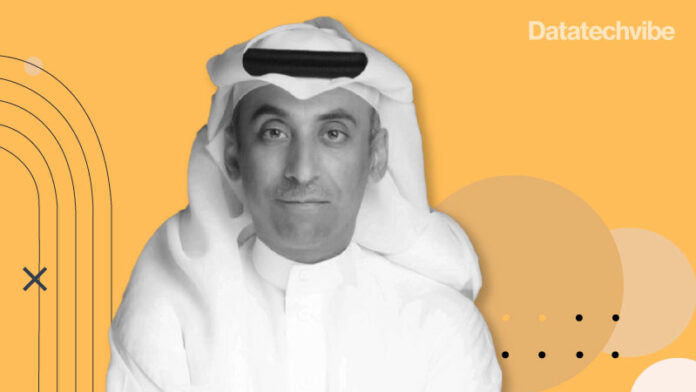Enterprises are using digital twin capabilities in multiple ways – its capabilities are more accessible to organisations large and small across industries.
The technology uses visualisation techniques to allow users to see the problems of physical objects or processes in depth without having to access them physically. Digital twins also save time and money on the design, testing, implementation and modification of products, systems and processes.
In an interview with Datatechvibe, Yaser Al-Jughaiman, CEO & Founder of IDT360 Transformation Consulting, discussed digital maturity among enterprises in the Kingdom, common challenges faced by the enterprises while accelerating digital transformation and what kind of disruptive technologies are transforming the Energy Industry into an intelligent enterprise.
Excerpts from the interview;
Tell us a bit about your journey and digital maturity among enterprises in the Kingdom.
My journey began as an engineer in different industries and departments, such as operations and asset management in supply chains, project management and quality control. I combined my experience and leadership experiences with a deep understanding of the characteristics of major industries from my past experiences, implementing, managing and directing the digital transformation process across various industries ranging from oil and gas utilities, energy manufacturing, marine construction, and other industries. I believe that more organisations and companies will adopt digital transformation in their strategy in the coming period. But the challenge remains, will everyone successfully implement digital transformation correctly?
What are the common challenges enterprises face when accelerating digital transformation?
Common challenges can be narrowed down to proper planning, the organisation’s readiness, the ready ground’s presence and the coordination of internal processes while undertaking the digital transformation process. There is no clear and correct strategy to carry out this transformation and this major change. Most organisations fall into the trap of not choosing the right technology for their transformation strategy. They choose complicated or expensive technology because of the lack of planning and clarity of vision.
Boards and CEOs believe that digital transformation is just an application of ICT. They assign technical departments to carry out the digital transformation process, which is a huge mistake. Whoever leads this transformation should be someone familiar with the industry itself.
Organisations today must understand digital transformation as an entirely new and innovative way to move their business into the future and prepare to withstand competition and growth. Therefore, you should consider everything when taking your digital transformation initiative – from how people will react to change, how it will affect customer relationships, cost, aligning with business goals, etc.
Tell us an example of how you help enterprises use data to improve operational excellence and customer experience.
Most organisations forget the most important stage of digital transformation, measuring the level of transformation they have achieved. Did they achieve the distinction they were striving for? Did they get a return on investment? Did they follow the best practices that lead to the quality of operations and the quality digital transformation?
I recommend companies be as accurate as possible in estimating the cost of digital transformation because we usually see a huge waste of budget without getting good results from the transformation.
Also, all activities, processes and data must be tracked to reduce costs and maintain project quality during the transformation process. This is done by achieving the maximum possible degree of transparency. Achieving a return on investment from digital transformation is related to the healthy management of costs and maintaining the project’s quality.
What do you mean by a holistic approach to change management and how can leaders implement it?
The transformation must affect the business directly. In order to achieve this effect, the organisation’s need for digital transformation must be understood. Based on this understanding, a road map is drawn up for the transformation project, and then it begins to apply this map on two levels; the first level deals with the internal departments of the organisation, such as the planning department, human resources, etc., and the second level deals with the core of the business, that is, the industry in which the institution specialises.
Most organisations make few mistakes: they start the digital transformation from the first level, that is, from the organisation’s internal departments. While the correct practice is to understand how the transformation will affect the industry in which the company is specialised, then start from there and return to the first level after that. A holistic approach, i.e. implementing digital transformation in line with the industry, internal and operational processes.
Since we are talking about the core business and the holistic approach, the role of the CEO in the digital transformation process must be mentioned here. Should he be fully involved in the transformation process? Or is it enough to just supervise it?
The only answer here, with certainty, is that the CEO should be the first responsible for the transformation process, and he should carry it out according to a holistic approach in order to ensure its success. He must be deeply involved at all operational levels, and this also requires him to be aware of the technical solution that he will rely on in the transformation process. Most CEOs may not find enough time to do all this, especially since the digital transformation processes in organisations can extend over several years. Or that many executives do not have enough experience or a full understanding of the technology solutions they will rely on. The solution here is the use of external expertise that is holistically familiar with the industry, core business, operations, leadership and management, in addition to the technological solution used in the digital transformation process. This external expertise must be qualified to apply the holistic approach to digital transformation.
What disruptive technologies are transforming the Energy Industry into an intelligent enterprise?
Digital twins will affect not only the energy industry but all different industries. If we project it to the energy industry, for example, we will get big, precise data to be the basis for developing artificial intelligence and machine learning. This data will be the key to understanding all the potential that we can get from energy and thus help us develop unique solutions and get the most out of it.
Digital twins are the key, they are the future.
The competitive advantage, especially for the energy and manufacturing sectors, will be the combination of engineering technology and OT technology, with IT technology and IoT to close the full cycle that includes operations, culture, user experience, customers and every angle of the industry.
This is what I call turning the dreams of digital transformation of the business into reality, that is, reaching the stage of digital twinning.
What are the key indicators to measure/understand the success of a digital transformation?
I believe digital transformation’s main success is fully supporting the business at all levels in one place. Imagine that digital transformation is a single control panel that controls all company operations at all levels smoothly and interconnectedly. It is similar to the process of assembly, where each part is complementary to the part before it, and then all these parts combine to form a cohesive structure.
Key metrics for successful digital transformation include reducing costs, maintaining project quality, achieving a return on investment, improving customer experience, and increasing operational efficiency.









